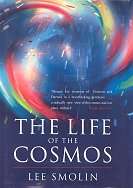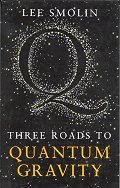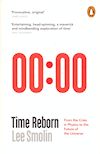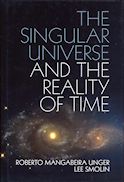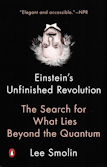Smolin lays out some problems he has with modern physics. He doesn't
mean problematic results; he is talking about problems with
the current process of doing physics that have led to an
unprecedented stalling of progress over the last 30 years. When he
says "physics", he means fundamental physics of gravity,
quantum mechanics, and particle physics, and the attempts to come up
with a unified theory, based on 30 years of research in
string theory. We can see this focus
from the start: in chapter 1, he identifies the five "great
unsolved problems of theoretical physics":
Problem
1: Combine general relativity and quantum theory into a single theory
that can claim to be the complete theory of nature.
Problem 2: Resolve the problems in the foundations of quantum
mechanics, either by making sense of the theory as it stands or by
inventing a new theory that does make sense.
Problem 3: Determine whether or not the various particles and
forces can be unified in a theory that explains them all as
manifestations of a single, fundamental entity.
Problem 4: Explain how the values of the free constants in the
standard model of particle physics are chosen in nature.
Problem 5: Explain dark matter and dark energy. Or, if they don't
exist, determine how and why gravity is modified on large scales. More
generally, explain why the constants of the standard model of
cosmology, including the dark energy, have the values they do.
He identifies these as the fundamental problems facing modern
theoretical physics, and the fact that no progress has been made on
them in the 30 years that string theory has held sway. It's not so
much that string theory has failed to make progress however; it's the
fact that the unprecedented dominance of one school of thought appears
to have stifled any progress on alternative approaches that might bear
fruit. Smolin himself is a theoretical physicist, a quantum gravity
researcher, who has also worked deeply on string theory, so is in an
ideal situation of knowing the field from outside, and from within.
This gives his critique a lot of credibility.
He starts off with an historical overview of the attempts over the
last century or more to unify the various forces of nature, and how
this has led to the "standard model" of particle physics,
and how gravity somehow never seems to fit. Actually, that last point
is not quite true:
p39.
In 1914, a Finnish physicist named
Gunnar Nordström found that all you had to do to unify gravity
with electromagnetism was increase the dimensions of space by one. He
wrote the equations that describe electromagnetism in a world with
four dimensions of space (and one of time), and out popped gravity.
Just by the extra dimension of space, you got a unification of gravity
with electromagnetism that was also perfectly consistent with
Einstein's special theory of relativity.
Unfortunately, the gravity that popped out was Newtonian
gravity, not General Relativity. So that's no good then. (But I am
greatly intrigued by the fact that it was Newtonian gravity
that popped out. Coincidence? Surely not. So why? Maybe it is "obvious"?
Because it is a good approximation? Because the same assumptions
underlying Newtonian gravity are there in the approach? Or some other
reason? Smolin does not go into this further.)
Despite not answering every single one of my questions(!), there is
lots of lovely stuff in here, and very nicely explained. I
particularly like the discussion of why physicists like to unify
forces (or other general concepts), and what doing so lets you do that
you could not do before. It's not intellectual thumb-twiddling: it
serves an important and powerful purpose. Smolin works his way from
early unifications to some very hairy string theory, keeping a
beautifully clear style throughout. Being a physicist, he explains
things using other, simpler physical analogies, such as this
description of emergent particles:
p132.
if you hit one end of a metal bar, a
sound wave will travel through it. The frequency at which the metal
vibrates is an emergent property, as is the speed that sound travels
in the metal. Recall the wave/particle duality of quantum mechanics,
which asserts that there is a wave associated with every particle. The
reverse is also true: There is a particle associated with every wave,
including a particle associated with the sound wave traveling through
the metal. It is called a phonon.
A phonon is not an elementary particle.
It is certainly not one of the particles that make up the metal, for
it exists only by virtue of the collective motion of huge numbers of
the particles that do make up the metal. But a phonon is a particle
just the same. It has all the properties of a particle. It has mass,
it has momentum, it carries energy. It behaves precisely the way
quantum mechanics says a particle should behave. We say that a phonon
is an emergent particle.
Things like this are believed to happen
to strings as well. When the interactions are strong, there are many,
many strings breaking and joining, and it becomes difficult to follow
what happens to each individual string. We then look for some simple
emergent properties of large collections of strings --- properties
that we can use to understand what is going on. Now comes something
really fun. Just as the vibrations of a whole bunch of particles can
behave like a simple particle --- a phonon --- a new string can emerge
out of the collective motion of large numbers of strings. We can call
this an emergent string.
The behavior of these emergent strings is
the exact opposite of that of ordinary strings --- let's call the
latter the fundamental strings. The more the fundamental
strings interact, the less the emergent strings do. To put this a bit
more precisely: If the probability for two fundamental strings to
interact is proportional to the string coupling constant g,
then in some cases the probability for the emergent strings to
interact is proportional to 1/g.
How do you tell the fundamental strings
from the emergent strings? It turns out that you can't --- at least,
in some cases. In fact, you can turn the picture around and see the
emergent strings as fundamental. This is the fantastic trick of
strong-weak duality. It is as if we could look at a metal and see the
phonons --- the quantum sound waves --- as fundamental and all the
protons, neutrons, and electrons making up the metal as emergent
particles made up of phonons.
However, rather than trying to do this for everything, when the
going gets too tough, he declines to attempt a bogus explanation, and
simply says it's too hard to explain in the space. That's fair enough:
this is a pop science book, not a graduate text, after all. Even so,
he manages to portray the beauty and excitement of the subject.
After the background explanation to help us understand what string
theory explains, or fails to explain, he evaluates its success. The
point to remember here is that string theory is about 30 years old
now, and never before in theoretical physics has a single approach
been employed, to the almost total exclusion of all other approaches,
for so long with so little to show for it. Is it fair to evaluate it
so soon? Well:
p178.
String theory either is or is not the
culmination of the scientific revolution that Einstein began in 1905.
...
One might ask whether it is too early to
make such an assessment. But string theory has been under continuous
development for more than thirty-five years, and for more than twenty
it has captured the attention of many of the brightest scientists in
the world. ... there is no precedent in the history of science, since
at least the late eighteenth century, for a proposed major theory
going more than a decade before either failing or accumulating
impressive experimental and theoretical support. Nor is it convincing
to point to the experimental difficulties, for two reasons: First,
much of the data that string theory was invented to explain already
exists, in the values of the constants in the standard models of
particle physics and cosmology. Second, while it is true that strings
are too small to observe directly, previous theories have almost
always quickly led to the invention of new experiments --- experiments
that no one would have thought of doing otherwise.
Quite damning. But surely it has given us some partial knowledge?
But no. Smolin describes that string theory is actually a whole Vast
family of theories. Some of these are known in detail -- they don't
work. Some, those that are supposed to give the right answers, are
merely conjectured to exist:
p181.
... any evaluation of string theory will
necessarily be controversial. If we restrict our attention to the
theories that are known to exist --- those that allow us to do actual
calculations and make predictions --- we must conclude that string
theory has nothing to do with nature, because every single one of
these disagrees with experimental data. So the hope that string theory
may describe our world rests wholly on a belief in string theories
whose existence is only conjectured.
It's as if Newton had come up with a whole family of theories of
gravity, with all those that could be worked out predicting square or
triangular orbits, and with some others merely conjectured to exist,
but if they did, they might give ellipses, and all being mediated by
invisible angels that were moving much too fast for us ever to be able
to see.
So why all the effort in string theory? Is it because there just are
no alternatives? Smolin says no. And it's not just loop quantum
gravity notions. He points out several observational anomalies, and
several interesting and potentially promising alternative approaches.
Of course, they might be completely wrong -- but shouldn't they at
least be investigated? (He's not here talking about obviously barking
"theories" by fringe lunatics; he's talking about
suggestions by serious, but non-mainstream, scientists.)
He starts off with some observations about a length scale defined by
the cosmological constant (itself a relatively recent observation,
currently "explained" by "dark energy"). This
length scale is enormous: comparable to the size of the observable
universe. We can use a standard trick in physics to convert this to a
different kind of unit, by combining with fundamental constants like
the speed of light c. (For example, the Planck length is
defined by a combination of the fundamental constants h, G,
and c.) R/c is roughly the age of the
universe: that is not surprising. But c2/R
is an acceleration, a tiny acceleration, and its value is
potentially interesting:
p211.
The other possibility is that there is
no dark matter and Newton's law of gravity breaks down whenever
accelerations get as small as the special value of c2/R.
In this case, there needs to be a new law that replaces Newton's law
in these circumstances. In his 1983 paper, Milgrom proposed such a
theory. He called it MOND, for "modified Newtonian dynamics."
According to Newton's law of gravity, the acceleration of a body due
to a mass decreases in a specific way when you move away from that
mass --- that is, by the square of the distance. Milgrom's theory says
that Newton's law holds, but only until the acceleration decreases to
the magic value of 1.2 x 10-8 cm/sec2. After
that point, rather than decreasing with the square of the distance, it
decreases only by the distance. Moreover, while normally the Newtonian
force is proportional to the mass of the body causing the acceleration
times a constant (which is Newton's gravitational constant), MOND says
that when the acceleration is very small, the force is proportional to
the square root of the mass times Newton's constant.
And the possible Pioneer trajectory anomalies involve a similar
acceleration, too. Smolin notes that such observations potentially
indicate something completely unexpected by theorists. (And given all
the earlier discussion of adding dimensions to get unified theories,
I'm amused to note that force decreasing proportional to the distance,
rather than distance squared, is what you would expect in a world
with only two spatial dimensions.)
Smolin continues with a whistle-stop survey of non-string
approaches, including twistors:
p244.
... Roger Penrose has also proposed an
approach to quantum spacetime based on the principle that what is
really fundamental is relations of causality. His approach is called
twistor theory. .... It is based on a reversal of the usual
way of seeing events in spacetime. Traditionally, one sees what
happens as primary and the relationships between what happens as
secondary. Thus the events are real and the causal relations between
the events are simply properties of the events. Penrose found that
this way of looking at things can be reversed. You can take the
elementary causal processes as fundamental and then define events in
terms of coincidences between causal processes. ....
.... In surprising and beautiful ways,
many of the basic equations of physics could be rewritten in terms of
twistor space. ... Twistor theory partly realizes the idea that
spacetime may emerge from another structure. The events of our
spacetime turn out to be certain surfaces suspended in the twistor
space. The geometry of our spacetime also emerges from structures in
twistor space.
But there are problems with this picture.
... No one yet knows what a quantum twistor space looks like. Whether
quantum twistor theory will make sense, and whether spacetime will
emerge from it, has yet to be shown.
He also speculates where there may be a fundamental problem
underlying our current conceptions, that old bugaboo, time:
p257.
... time is represented as if it were
another dimension of space. Motion is frozen, and a whole history of
constant motion and change is presented to us as something static and
unchanging. ....
We have to find a way to unfreeze
time --- to represent time without turning it into space. I have
no idea how to do this. I can't conceive of a mathematics that doesn't
represent a world as if it were frozen in eternity. It's terribly hard
to represent time, and that's why there's a good chance that this
representation is the missing piece.
One thing is clear: I can't get anywhere
thinking about this kind of problem within the confines of string
theory. Since string theory is limited to the description of strings
and branes moving in fixed-background spacetime geometries, it offers
nothing for someone who wants to break new ground thinking about the
nature of time or of quantum theory.
Of course, Smolin is interested in quantum gravity, covered very
well in his earlier book, Three Roads to Quantum
Gravity. Again, he makes the point that a unified theory
should be background-independent in order to incorporate gravity.
Maybe starting with background-dependent theories (such as string
theory) and then hoping to patch it up later just can't work. (After
all, Newtonian gravity pops out of Nordstrom's work with EM, yet the
move from Newtonian gravity to General Relativity isn't a fix-up, it's
a complete paradigm shift. So maybe even if string theory were to "pop
out" of some background-dependent theory, it could turn out to be
to the "real" theory as Newtonian gravity is to GR. Not
good.)
But it's not just a case of building in the "right"
background. Maybe, for a truly fundamental theory of space-time, the
space (and time?) should emerge from, not be built into, the
theory:
p240.
Don't start with space, or anything
moving in space. Start with something that is purely
quantum-mechanical and has, instead of space, some kind of purely
quantum structure. If the theory is right, then space must emerge,
representing some average properties of the structure --- in the same
sense that temperature emerges as a representation of the average
motion of atoms.
So this is a great description of the current status of fundamental
theoretic physics. And, as has been mentioned before, there's a
problem: progress has stalled. But why? That is Smolin's topic for the
final part of his book. He stops looking at just the science, and
looks at how science is done, the social processes involved. He has a
nice take on the philosophy of the scientific method: it's not one
simple approach like Popperianism, but rather a collection of
approaches that have been developed and honed. And these approaches
are domain-dependent: what works well in theoretical physics need not
work as well in biology, for example, because the properties of the
two domains are quite different: the kinds of regularities the
approach exploits are different in different domains, so could benefit
from different approaches.
pp298-9.
Science was not invented. It evolved
over time, as people discovered tools and habits that worked to bring
the physical world within the sphere of our understanding. Science,
then, is the way it is because of the way nature is --- and because of
the way we are.
... The successful strategies were
discovered over time and are embedded in the practices of the
individual sciences.
Once we understand this, we can identify
the features of nature that science exploits. The most important is
that nature is relatively stable. In physics and chemistry, it's easy
to devise experiments whose results are repeatable. This did not have
to be the case; for example, it is less the case in biology and far
less in psychology. But in the domains where experiments are
repeatable, it is useful to describe nature in terms of laws. Thus,
from its beginnings, the practitioners of physics have been interested
in discovering general laws. What is at issue here is not whether
there actually are fundamental laws; what matters for how we do
science is whether there are regularities that we can discover and
model, using tools that we can make with our hands.
These scientific approaches do not exploit only the structure of
nature. Just as importantly, they have been carefully honed to exploit
and compensate for our peculiarities, particularly our ability
to fool ourselves.
pp299-300.
But if science works because we live in
a world of regularities, it works in the particular way it does
because of some peculiarities in our own makeup. In particular, we
are masters at drawing conclusions from incomplete information.
.... We never have enough information to completely justify the
conclusions we draw. Being able to act on guesses and hunches, and act
confidently when the information we have points somewhere but does not
constitute a proof ... is a big part of what makes human beings such a
successful species.
But this ability comes at a heavy price,
which is that we easily fool ourselves. ....
.... And we fool ourselves not only
individually but en masse The tendency of a group of human
beings to quickly come to believe something that its individual
members will later see as obviously false is truly amazing. .... But
arriving at a consensus is part of who we are, for it is essential if
a band of hunters is to succeed or a tribe is to flee approaching
danger.
For a community to survive, then, there
must be mechanisms of correction: elders who curb the impulsiveness of
the young because if they have learned anything from their long lives,
it is how often they were wrong; the young, who challenge beliefs that
have been held obvious and sacred for generations, when those beliefs
are no longer apt. Human society has progressed because it has learned
to require of its members both rebellion and respect, and because it
has discovered social mechanisms that over time balance those
qualities.
I believe that science is one of those
mechanisms. It is a way to nurture and encourage the discovery of new
knowledge, but more than anything else it is a collection of crafts
and practices that, over time, have been shown to be effective in
unmasking error. It is our best tool in the constant struggle to
overcome our built-in tendency to fool ourselves and fool others.
So, science requires "both rebellion and respect".
Smolin's contention is that currently, the rebellion side of the coin
is being stifled in theoretical physics. He cites several reasons, but
the main one appears to be the ultra-conservative hiring policies in
(US) universities. Rebels don't join big established teams researching
conventional (here, string theoretic) approaches; rebels have
difficulty getting published; so rebels have difficulty getting
grants; so rebels don't get tenure. (Smolin points out how,
ironically, some of the founder members of string theory were
themselves rebels ploughing a lonely furrow, suffering from precisely
this conservatism, until string theory took off and they became
respected mainstream "overnight".) Smolin makes some
eminently sensible suggestions for how to overcome this problem, for
how to ensure that a certain proportion (it does not have to be large)
of these rebels, or "seers", can get appointed and given the
opportunity to flourish. But how to get anyone in a position to do
anything about it to listen? Well, the Perimeter Institute for
Theoretical Physics in Ontario, where Smolin is now a faculty member,
seems to have some of the right ideas. So there is one place that
sanity reigns, hopefully.
This is a great book, with clearly-written fascinating science, and
thought-provoking discussions on the way science is (or ought to be)
done. Although focussed on fundamental physics, some of the latter
discussion is much more widely applicable. Recommended.
